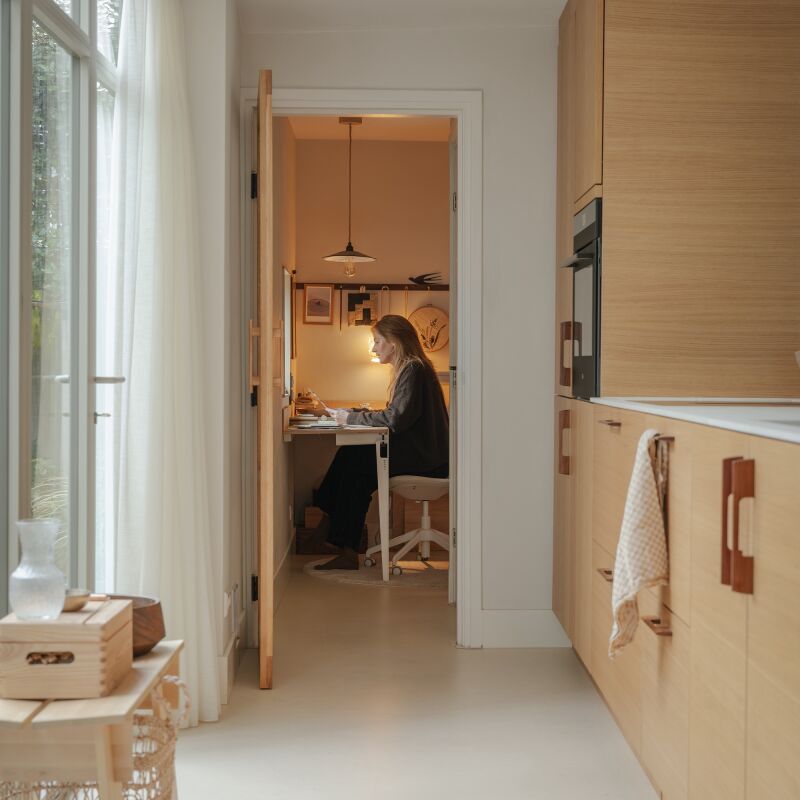The first time they saw the Spanish-style stucco house on a quiet side street, LA-based landscape designers Joel Lichtenwalter and Ryan Gates of Grow Outdoor Design didn't really see it. They couldn't, because of the humongous hydrangeas and overgrown philodendrons in the front yard. This week, they reveal how they turned a "tropical mess" into a welcoming front garden on a budget of about $10,000. For the next 48 hours, they will answer any and all questions. Ask away in the comment section below:
"The homeowner wanted a garden that would be more welcoming to the neighbors, and also more eco-friendly," says Lichtenwalter. "The challenge was to open up the house to the street." Here's how they did it.
Photographs by Katrina Coombs via Grow Outdoor Design.

Above: Lichtenwalter and Gates favor using a muted color palette—typically limited to greens, browns, and silvers. "And then we have one color be the 'pop,' " says Lichtenwalter. In this garden, orange was the "pop."
The Grow Outdoor Design planting scheme emphasized using natives and Mediterranean plants—so the homeowners could cut back on water—that honored the architecture of the house. "We cleared out all the water-thirsty plants and started fresh," says Gates.
The permeable paths are decomposed granite mixed with a stabilizer and installed over layers of compressed crushed stone. Decomposed granite, a "soft" organic surface, also is a good choice for bocce courts and play areas. It requires no maintenance except to add a fresh layer of stone every few years.

Above: Money saving tip No. 1: Agree on a good plan and stick to it. "We gave them two different designs, one more formal and one more informal as far as how the space was broken up," says Lichtenwalter.
One plan had square concrete pads in a modern geometric pattern; the other used natural flagstone pieces. "In the end we came up with a compromise of the two designs, using the more natural materials, but in a more geometric pattern," says Lichtenwalter.
Although the space is small, the design included a "grove" of trees consisting of three redbuds—Cercis canadensis 'Forest Pansy'—near the driveway. The idea was to give the clients the experience of passing through a grove of trees as they walked from the driveway to the house. To balance the "grove," the other side of the property got an olive tree to replace the messy philodendrons and some ficus.

Above: The "Before" view. "You couldn't even see the house," says Lichtenwalter. "It was like walking into a jungle and it needed a lot of water. Ecologically, this wasn't the smartest use of the space."
One way to keep a complete overhaul of a space budget friendly is to "plant small," Lichtenwalter says. A plant in a 1-gallon pot costs approximately $5, whereas a 5-gallon pot may be $15. All the new grasses, succulents, and perennials came in 1-gallon pots.
"Trees we tend to buy bigger," says Lichtenwalter; the size of choice is a tree in a 24-inch box.

Above: On the stucco wall: a velvety cloak of creeping fig (salvaged from the overgrown front garden). The vine is particularly useful for narrow spaces or walkways. It hugs the wall on which it grows. Over time, however, a single plant will spread to cover an entire wall, growing as much as 10 feet in either direction in one year. "You do selective pruning to keep it tight," says Lichtenwalter. "The new growth is so nice and has small, tiny leaves. But as it gets bigger so do the leaves. So you prune the branches that get too big. That encourages new growth."

Above: A money-saving suggestion: Rather than paving an entire path with flagstone, set individual pavers into a bed of decomposed stone to create a walkway. Here the Arizona dark pink flagstone is framed by a ground cover—Dymondia margaretae—that grows well between stones because it has a deep taproot (rather than shallow roots that need to spread out at the surface). Periodically, it sends forth a sparse yellow flower.

Above: Euphorbia rigida 'Gopher Spurge' and Agave vilmoriniana (Octopus Agave) complement each other with different textures, sizes, and shapes of their leaves.
"We always choose plants for their ultimate size," says Lichtenwalter. "You don't want to be constantly pruning something to make it fit in a space that's too small. The idea of 'right place, right plant' will save money because you won't have to replace plants that shouldn't have been there in the first place."

Above: A redbud tree and a native grass (Canyon Prince Wild Rye). "It gives the idea of walking through a meadow with a growth of trees above it," says Lichtenwalter.

Above: Cape Rush. It's a hardy grass that needs minimal maintenance. "Just selective pruning every once in a while to keep it tighter," says Lichtenwalter, "otherwise it will fall over."
(N.B.: Looking for more dry garden inspiration? See "A Garden You Water Four Times a Year."




Have a Question or Comment About This Post?
Join the conversation (0)